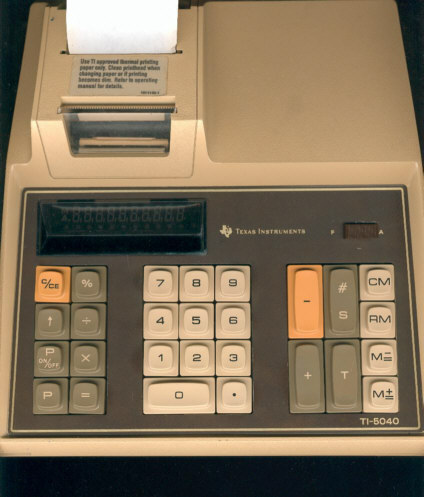
DATAMATH CALCULATOR MUSEUM
 |
DATAMATH CALCULATOR MUSEUM |
Texas Instruments TI-5040
| Date of introduction: | 1976 | Display technology: | Fluorescent |
| New price: | $149.95, £109.95 DM 498.00 |
Display size: | 10 |
| Size: | 9.5" x 9.2" x 2.7" | Printer technology: | Thermal TP-20225, TP-27225 |
| Weight: | 3 pounds 5 ounces | Serial No: | 1409135 |
| Batteries: | Date of manufacture: | wk 20 year 1981 | |
| AC-Adapter: | 120 V | Origin of manufacture: | USA |
| Precision: | 10 | Integrated circuits: | TMC0261 |
| Memories: | 1 + 1 | ||
| Program steps: | Courtesy of: | Joerg Woerner | |
| Download manual: | |
 It
took a long time between the first calculator based on TI's thermal printer
technology - the Canon Pocketronic - and this universal printing desktop
calculator. Introduced 1976 it features both a 10 digit fluorescent display and
a quiet, convenient thermal printer. Together with a 4-key memory this
calculator defined the standard in its class.
It
took a long time between the first calculator based on TI's thermal printer
technology - the Canon Pocketronic - and this universal printing desktop
calculator. Introduced 1976 it features both a 10 digit fluorescent display and
a quiet, convenient thermal printer. Together with a 4-key memory this
calculator defined the standard in its class.
This calculator was a great success for Texas Instruments, it was produced more than 5 years before the TI-5142 was introduced. Later models like the TI-5040 II or the TI-5130 had shorter life cycles.
The style of the keyboard and some design elements of the TI-5040 were adopted both by non-printing calculators like the TI-5100 and print-only calculators like the TI-5015.
The TI-5220 printing desktop calculator with similar specifications but sporting a 12 digits display was introduced in 1977 together with its huge sibling TI-5225. Don't miss the TI-5135 introduced in 1980.
The first portable printing calculator TI-5050 appeared one year earlier on the market.
Even Texas Instruments never mentioned the rare TI-500, a printing calculator introduced already in 1974.
| TI-5040
Offers the best of two worlds. An easy-to-read display. A printed tape. © Texas Instruments, 1981 |
If you have additions to the above article please email: joerg@datamath.org.
© Joerg Woerner, December 5, 2001. No reprints without written permission.